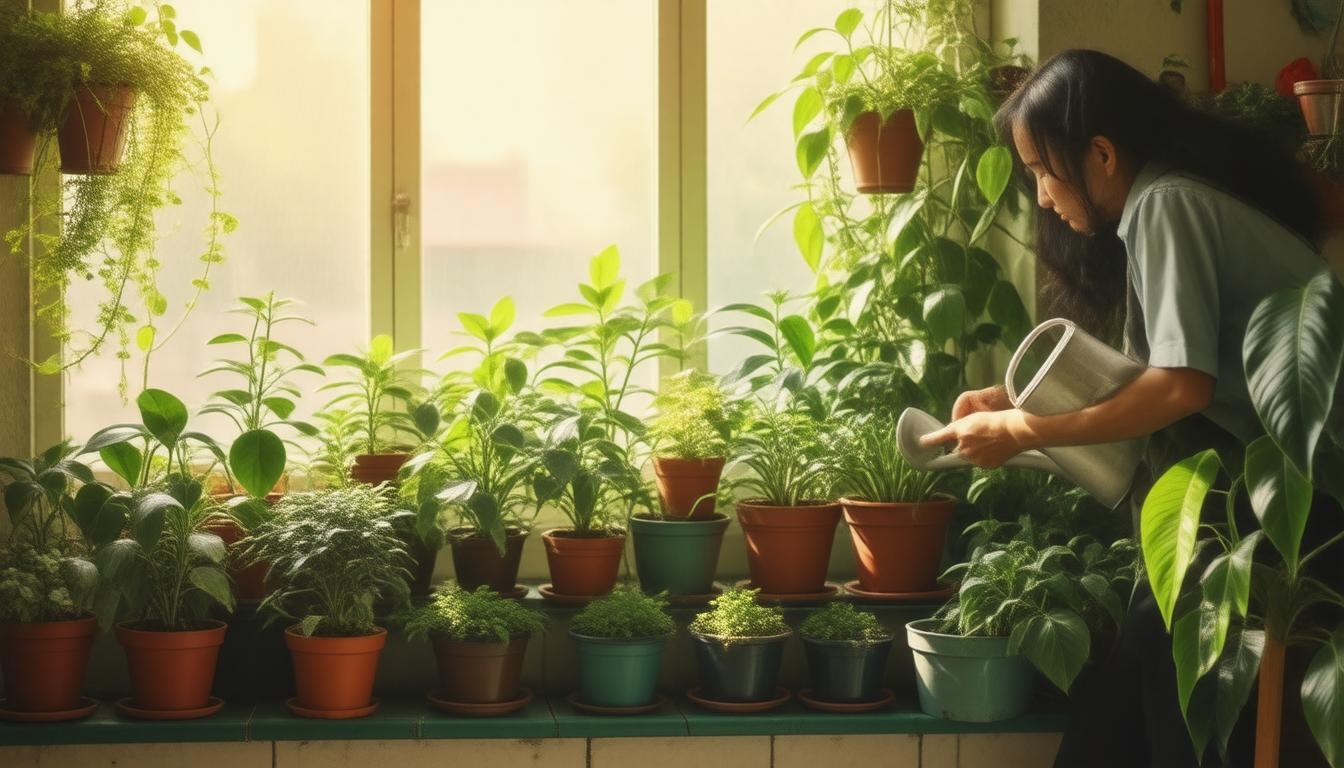Indoor plants not only add beauty to your home but also improve air quality and create a serene atmosphere. However, keeping them healthy year-round can be a challenge if you’re not equipped with the right knowledge. In this article, ‘The Ultimate Guide to Indoor Plant Tips: Keep Your Plants Healthy Year-Round,’ we will explore essential tips on understanding indoor plant needs, choosing the right plants for your space, light requirements, watering and humidity considerations, managing pests and diseases, and seasonal care tips. Whether you’re a novice plant parent or a seasoned green thumb, this comprehensive guide will help you cultivate a thriving indoor garden that flourishes with life.
Key Takeaways
- Understand the specific needs of indoor plants to ensure their health and longevity.
- Select plants that are suitable for your living space to enhance their growth and vitality.
- Different plants have varying light requirements; match plants to available light for optimal growth.
- Proper watering and humidity levels are crucial for preventing plant stress and disease.
- Seasonal care tips can help you adjust your indoor plant care routine throughout the year.
Understanding Indoor Plant Needs
Understanding indoor plant needs is crucial for anyone looking to maintain a vibrant and healthy indoor garden. In ‘The Ultimate Guide to Indoor Plant Tips: Keep Your Plants Healthy Year-Round,’ we delve into the essentials of indoor plant care, helping you navigate the complexities of light, water, humidity, and temperature requirements. Each plant species has its own unique set of preferences; therefore, it is vital to research and understand these specifics to ensure optimal growth. For instance,
Houseplants such as succulents thrive in bright, indirect sunlight, while ferns prefer higher humidity and lower light levels. Furthermore, overwatering is a common pitfall that can lead to root rot, whereas underwatering can stress your plants. Regularly checking soil moisture and adjusting your watering schedule according to seasonal changes can help maintain a healthy indoor ecosystem. By following these tips and paying close attention to your plants’ individual needs, you can create the perfect environment that keeps your indoor greenery flourishing throughout the year.
Choosing the Right Plants for Your Space
When it comes to creating a vibrant indoor oasis, choosing the right plants for your space is crucial. The Ultimate Guide to Indoor Plant Tips: Keep Your Plants Healthy Year-Round emphasizes the importance of selecting flora that not only fits your aesthetic preferences but also thrives in your specific environment. Consider factors such as light levels, humidity, and temperature before making a decision. For instance, if your living space boasts abundant natural light, you might opt for sun-loving varieties like succulents or fiddle leaf figs. Conversely, in areas with lower light conditions, shade-tolerant plants such as snake plants or pothos can flourish beautifully. It’s essential to assess your lifestyle as well; if you travel often or have a busy schedule, low-maintenance plants like ZZ plants may be the ideal choice. By thoughtfully selecting the right plants and applying tips from the ultimate guide, you can ensure their health and vibrancy all year round.
‘The best time to plant a tree was twenty years ago. The second best time is now.’ – Chinese Proverb
Light Requirements for Different Types of Plants
When it comes to maintaining a thriving indoor garden, understanding the light requirements for different types of plants is essential. This knowledge plays a pivotal role in your indoor gardening success and falls right in line with our keyword focus: The Ultimate Guide to Indoor Plant Tips: Keep Your Plants Healthy Year-Round. For instance, low-light plants like snake plants and pothos are perfect for dimly lit corners, while tropical plants such as peace lilies and ferns flourish in bright indirect light. On the other hand, flowering plants like African violets and some succulents thrive in direct sunlight for several hours a day. Providing the right intensity and duration of light—whether through natural sunlight or artificial grow lights—will ensure your plants receive the energy they need to photosynthesize, grow, and ultimately, brighten your indoor spaces. Remember, each plant species has its unique light preferences, and making adjustments based on their specific needs is key to maintaining a healthy indoor environment.
Watering and Humidity Considerations
When it comes to keeping your indoor plants healthy year-round, watering and humidity are crucial factors that can significantly affect their growth and vitality. Many indoor gardeners often overlook the importance of these elements, yet they play a vital role in the overall health of your greenery. In the Ultimate Guide to Indoor Plant Tips: Keep Your Plants Healthy Year-Round, we emphasize the need for a proper watering schedule, which can vary depending on the type of plant you own and the time of year. For instance, during the warmer months, most plants tend to require more frequent watering compared to winter months when they enter a dormant phase. Additionally, maintaining adequate humidity levels is essential for tropical plants, which thrive in a more humid environment. Using tools such as a hygrometer can help monitor humidity, ensuring that your plants are placed in an optimal environment. Regular misting or incorporating a pebble tray can also help in elevating humidity and providing a thriving habitat for your indoor greenery.
Managing Pests and Diseases
Managing pests and diseases is a crucial aspect of maintaining healthy indoor plants, and our comprehensive resource, ‘The Ultimate Guide to Indoor Plant Tips: Keep Your Plants Healthy Year-Round,’ is here to help. Keeping your plants free from infestations requires a combination of vigilance and preventive measures. Start by regularly inspecting your plants for signs of pests, such as discolored leaves or sticky residue, and take immediate action if you notice any abnormalities. Natural remedies like neem oil or insecticidal soap can effectively tackle common nuisances like aphids and spider mites without harming your plants. Additionally, ensure adequate air circulation to deter mold and mildew, and remember that overwatering can lead to root rot and fungal diseases. By implementing these strategies, you can create a thriving indoor environment and enjoy the beauty of your plants all year long.
Seasonal Care Tips for Indoor Plants
Indoor plants can bring a refreshing touch of nature into your home, but their care needs can vary significantly with the seasons. In this section of the Ultimate Guide to Indoor Plant Tips: Keep Your Plants Healthy Year-Round, we delve into seasonal care strategies to ensure your greenery thrives throughout the year. During the spring, as the days lengthen and temperatures warm, it’s essential to gradually increase the amount of sunlight your plants receive, while also ensuring they have ample water to encourage new growth. As summer approaches, maintaining humidity becomes crucial—consider misting your plants or placing a humidifier nearby to replicate their natural habitats. When autumn arrives, many plants enter a period of dormancy; reduce watering and allow them to rest, paying close attention to any signs of stress. Finally, winter demands even more vigilance; place your plants away from drafts and heaters, and provide additional grow lights if natural light is scarce. By following these seasonal care tips, you’ll be well-equipped to keep your indoor plants flourishing all year, enhancing both your home’s aesthetics and your overall well-being.
Frequently Asked Questions
What are the essential needs of indoor plants?
Indoor plants generally need proper light, appropriate watering, adequate humidity, and nutrients from the soil. Understanding these needs ensures they thrive in your home.
How do I choose the right indoor plants for my space?
When selecting indoor plants, consider factors like the amount of natural light your space receives, the humidity levels, and your ability to maintain the care requirements of different plants.
What light requirements should I consider for indoor plants?
Different plants have varying light needs—some prefer bright, direct sunlight while others thrive in low-light conditions. Identify your plant’s specific requirements and position them accordingly.
How often should I water my indoor plants?
The watering frequency depends on the type of plant, the potting medium, and the environment. Generally, it’s best to check the soil moisture before watering and ensure that the pot has drainage to prevent root rot.
How can I manage pests and diseases in indoor plants?
Regularly inspect your plants for signs of pests or diseases, maintain cleanliness around your plants, and use organic pest control methods as needed. Quarantine any affected plants to prevent the spread of issues.




